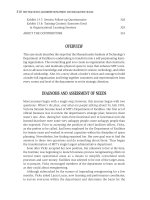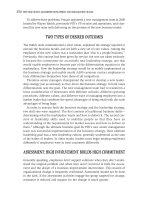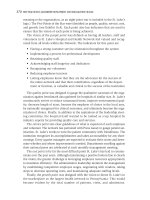Tài liệu Best Practives in Leadership Development & Organization Change 19 pptx
Bạn đang xem bản rút gọn của tài liệu. Xem và tải ngay bản đầy đủ của tài liệu tại đây (160.39 KB, 10 trang )
Participant Information
Name:
Current Position:
Service Line:
Hire Date:
Learning Contract Date:
Participant Initials:
Leadership Steward Initials:
Career Advancement Targets
What do I want to achieve?
What obstacles stand in the way?
What am I doing now to get what I want?
(focus on continuing what is working and
ceasing what isn’t)
Is my behavior helping? (Why/why not?
What behaviors need changing?)
Exhibit 5.6. Learning Contract
cart_14399_ch05.qxd 10/19/04 12:07 PM Page 150
Assessment Feedback Action Plan
How Will I Gain This Skill/
Identified
Knowledge? How Does This How Will I
Developmental My Learning Action Address My
Evidence My Growth Resource/Help Target
Need
Objective Development Need?
in This Area Required Completion Date
Exhibit 5.6. (
Continued
)
Source:
©
Confidential and Proprietary to First Consulting Group. R
eprinted with permission.
cart_14399_ch05.qxd 10/19/04 12:07 PM Page 151
152
BEST PRACTICES IN LEADERSHIP DEVELOPMENT AND ORGANIZATION CHANGE
LEADERSHIP FIRST SESSION ONE
Team Exercise—Business Models and Their Implications
You have been provided with information covering the recent history of FCG’s
Health Delivery Practice. Using this material and drawing upon the information
presented and discussed in this afternoon’s session:
• Identify the business forces acting on the HD model in late 1999 and early
2000 and determine how it was positioned to either respond or not respond to
the changing environment.
• What were the existing business model levers and how were they structured
to either respond or not respond to the market changes?
• Which lines of business or services should be reduced or not emphasized?
• Which segments would you invest in and how would you fund those
investments?
• How will you increase marketing and marketing effectiveness?
• What key processes and reports must you put in place immediately to
manage the business?
• The ultimate goal is to return the unit to profitability over the shortest period
possible: within what time frame will you accomplish this?
• How will you position and structure the unit to both deal with the immediate
challenges while positioning for a return to acceptable growth rates?
Be prepared to make a twenty-five-minute presentation of your team’s analysis
and strategy, covering the questions identified above.
Time Frame for Team Exercise: 1 hour 45 minutes
Exhibit 5.7. Business Model Exercise
cart_14399_ch05.qxd 10/19/04 12:07 PM Page 152
FIRST CONSULTING GROUP
153
The Health Delivery Business Unit Background Information
Background
Through the year 2000, the Health Delivery Business Unit had been one of the
mainstays of FCG’s practice. This business unit, and the related service offerings,
had its roots in the founding practices of the firm. The portfolio of services
comprised two major lines of business: IT consulting services and implementation
services. In addition, there was a small process improvement line of business that
had a spotty past history in terms of market penetration and success, and had
limited internal acceptance within the overall HD group. As shown below, there
were sub or component offerings in each of these major lines of business.
Health
delivery
FCG's 1999
Health Delivery Business Unit
Implementation
services
Consulting
services
• System configuration
• Implementation
• System test
• System integration
• Systems planning
• Vendor selection
• Executive studies
• Process analysis
• Process redesign
• Benefits realization
Process
improvement
services
In addition to the delivery group, there was an overlay “sales” or go-to-market
structure. The regional sales force was made up of geographic-based VPs and sev-
eral new business directors, whose major responsibility was to sell the full line of
the firm’s services into the health delivery market (this included not only the core
service offerings provided by the HD business unit, but also HD applicable services
provided by other business units such as technology and integration services,
networking design and implementations, and e-health services). The sales force
Exhibit 5.7. (Continued)
(Continued)(Continued)
cart_14399_ch05.qxd 10/19/04 12:07 PM Page 153
154
BEST PRACTICES IN LEADERSHIP DEVELOPMENT AND ORGANIZATION CHANGE
was responsible for identifying and prioritizing “target” accounts, developing
marketing and sales strategies, and maintaining “strategic” relationships with key
accounts.
The delivery components of the HD business unit were organized on a service-line
or service-offering basis and did not have specific assigned geographies or specific
account sales responsibilities. Their focus was to support the “sales” process by
providing specific functional expertise to support the proposal process, identifying
and selling add-on work, managing the quality and economics of the projects,
developing additional service offerings or products, managing overall utilization for
their groups, and related hiring and HR management issues.
The business unit was designed and structured to capitalize on what had been a
twenty-year trend in the HD marketplace:
• Maintain strong relationships at existing or new HD accounts and use the con-
sulting services to drive systems planning and vendor selection services into
the client base.
• Use the planning and system selection process to “tee up” subsequent, large-
scale, and multimonth or multiyear implementation engagements.
• Sell additional “consulting” services in the areas of process improvement if we
had the skills and expertise.
• Repeat the cycle every three to five years at the client when the old systems no
longer meet their needs.
Years 1999 and Early 2000 HD Market Dynamics
The majority of 1999 continued the successive string of strong quarters for the
HD business unit. Buoyed by the tremendous demand fueled by the Y2K problem,
almost all the HD organizations began an accelerated cycle of systems
replacements. The Y2K phenomenon also created additional demand for “body
shop” Y2K testing and remediation support. This demand resulted in the following
1999 revenue and project margin performance for all services delivered into the HD
marketplace.
Beginning in 1999 and continuing into early 2000, there was an abrupt and
precipitous decline in market demand. The factors contributing to this were
• The Balanced Budget Act (BBA) began to seriously erode health delivery organi-
zations’ operating margins. BBA went into effect in 1998, and the full impact began
to be felt through reduced federal reimbursement in 1999. BBA was a permanent
reduction in the level of government reimbursement for health care services.
Exhibit 5.7. Business Model Exercise (Continued)
cart_14399_ch05.qxd 10/19/04 12:07 PM Page 154
FIRST CONSULTING GROUP
155
• The overspending in 1998 and 1999 on systems for Y2K readiness shut down
capital for IT in 2000.
• Executive management seriously questioned the “value” received for past IT
expenditures and the need for future investments.
• All major IT vendors (except Cerner and several smaller firms) experienced
significant sales and revenue declines.
As a result, the 1st and 2nd Q FY 2000 operating performance of the HD business
unit “tanked.” The overall structure, personnel assignments, and reporting for-
mats were realigned starting in FY 2000. However, the relative operating metrics
still reflected a significant decline in performance.
FY 200 HD Operating Metrics
Quarter Revenue COS GM % Selling G&A Op. Inc. Op. Inc. (%)
Q1 $13,347 $8,044 $5,303 39.7% $1,784 $1,454 $2,065 15.5%
Q2 $10,914 $6,955 $3,959 36.3% $1,617 $1,574 $768 7.0%
Fact Gathering Results
The leadership of the HD business unit began a series of fact-gathering and analy-
sis exercises beginning in March 2000. This fact gathering focused on garnering
input on current and projected market demand, analysis of the operating statistics,
review of the services portfolio and offerings, and review of the existing sales and
Exhibit 5.7. (Continued)
35,000,000
30,000,000
25,000,000
20,000,000
15,000,000
10,000,000
5,000,000
0
Net revenue
1st
Qtr
'99
2nd
Qtr
'99
3rd
Qtr
'99
4th
Qtr
'99
Project margin
(Continued)(Continued)
cart_14399_ch05.qxd 10/19/04 12:07 PM Page 155
156
BEST PRACTICES IN LEADERSHIP DEVELOPMENT AND ORGANIZATION CHANGE
delivery organization structures. Throughout the process, there was significant
debate, conflicting opinion, and contradictory recommendations. A summary of the
salient facts and opinions include
• There were no firm data on what the market was currently demanding or
likely to demand in the immediate future. Data from the vendors indicated that
for the remainder of 2000, and potentially well into 2001, demand for software
and new implementation business would be weak. The number of FCG driven
systems plans and vendor selections fell to an average of one to two new
engagements per month.
• There was a growing “rift” between the HD sales and delivery organizations.
The delivery components of the organization felt that the sales side was not
effectively pursuing the market opportunities, and the sales side felt that there
was limited market demand and the HD service offerings no longer met the
market demand they were pursuing.
• Many of the old vendor-based implementation services were no longer
“selling” in the marketplace. The demand for McKesson Robbins HBOC
software, IDX software, and SMS software was in significant decline. These
had been mainstays of the implementation services business.
• Given the falling demand in the marketplace, significant price-cutting
began to appear. The vendors and other consulting firm’s began to cut rates
by 20 to 40 percent in an effort to offset fixed costs.
• The existing measurement and monitoring systems were not strong or
sufficient to analyze current or future performance. Specifically:
The sales forecast process was imperfect and at best showed that future
demand was weak or nonexistent.
There were no clear lines of accountability or measurement of sales and
delivery effectiveness.
There were no tools or practices in place to monitor the controllable cost
components of the business unit; e.g. practice development direct expenses,
other nonchargeable expenses, sales cost, and time by client type or
geography.
Account plans were nonexistent.
Use the facts, data, and opinions detailed above to support your analyses and
recommendations for the exercise.
Exhibit 5.7. Business Model Exercise (Continued)
Source:
©
Confidential and Proprietary to First Consulting Group. Reprinted with permission.
cart_14399_ch05.qxd 10/19/04 12:07 PM Page 156
FIRST CONSULTING GROUP
157
Drawing upon the assigned prereading materials, the ideas from today’s group
discussion, and the attached FCG Acquisition Checklists, evaluate the following
candidate company as a potential FCG acquisition:
• Identify what potential acquisition strategies may be possible here. Explore with the
group not only a wholesale acquisition (if you can make the economics work) but
also other forms of acquisition or investment that meet both organization’s goals.
• Settle on your best option and develop a short, 4–5-page PowerPoint presentation
outlining the following:
The basic structure of the deal
The strategic advantages and gains for both organizations
Time frame and economics
Major “Due Diligence” tasks
Risks
• If, as a group, you are unable to structure a deal that leads to some form of
combining (this can be a viable strategic option), prepare a 4–5-page PowerPoint
presentation outlining the following:
How the two companies will work together—the relationship structure and
the leadership structure.
How you will position the relationship in the marketplace.
The targeted growth and profitability for the specific ERP practice.
How you will manage the risks associated with not having a formalized
relationship and structure and how you will manage the potential for (company
name) selling (company name) to another organization.
How/where does it fit with FCG’s current business strategy and structure?
What particular advantages/opportunities does it provide for FCG?
What are the revenue/profitability potentials?
What is the “culture fit” between the two firms?
Can a deal be put together? Why or why not?
What would the deal structure look like?
How does the staff/skills set fit into FCG? Would we retain everyone or would
some have to be released?
What are the liabilities/risks associated with this acquisition?
Should FCG buy this company?
Be prepared to make a twenty-minute presentation of your team’s analysis and
recommendation (be sure to address all the questions above in your presentation).
Time Frame for Team Exercise: 1 hour 30 minutes
Exhibit 5.8. Managing Acquisitions and Mergers Exercise
Source:
©
Confidential and Proprietary to First Consulting Group. Reprinted with permission.
cart_14399_ch05.qxd 10/19/04 12:07 PM Page 157
158
BEST PRACTICES IN LEADERSHIP DEVELOPMENT AND ORGANIZATION CHANGE
Effective today, you have been named CEO. You and your management team
have gathered to define the communication requirements of the firm and define
a communication strategy and plan for the firm.
Drawing upon the assigned prereading materials, the ideas from today’s group
discussion, and your knowledge of the firm:
• Think about the various constituencies and discuss their particular perspective
regarding FCG: What are their key communication issues and need for infor-
mation? Spend adequate time in discussing the issues before proceeding to the
creation of your plan.
• Design a communications strategy and plan for your administration: identify
how many and specifically which constituencies you will communicate with,
regarding what issues, and with what frequency (consider vendors, clients,
auditors, attorneys, board, market analysts, executive committee, VPC, VPDC,
and any others you think are needed).
• Describe the vehicle(s) you would employ to communicate with those
groups/entities and define the manner in which you would evaluate the
effectiveness of that communication initiative.
Be prepared to make a twenty-minute presentation of your team’s analysis
and recommendation (be sure to address all the questions above in your
presentation).
Time Frame for Team Exercise: 1 hour 30 minutes
Exhibit 5.9. Effective Communication Exercise
Source:
©
Confidential and Proprietary to First Consulting Group. Reprinted with permission.
cart_14399_ch05.qxd 10/19/04 12:07 PM Page 158
FIRST CONSULTING GROUP
159
1. Between now and Session Two, interview your business unit leader and pre-
pare an assessment of your business unit. Identify and address the following:
• Briefly describe the business unit’s organizational structure
• Describe the current business model
• Identify the current and future key business drivers and market
opportunities
• Identify the unit’s relative strengths and weaknesses
• Describe the unit’s skill set strengths and deficiencies
• Identify the risks, exposures, and opportunities that will exist twelve to
twenty-four months in the future
• Outline how you would accelerate the growth of the unit 50 percent above
its current level over the next twelve to eighteen months.
Be prepared to make a presentation (no more than 20 minutes in length) of your
analysis to the entire Leadership First group at the next session. This presentation
should be an original-thought, focused analysis of the issues—not merely an acad-
emic exercise or a compendium of other presentations that may have been done
by members of the business unit.
2. Using your assessment feedback information as the basis for your personal
growth and learning strategy, complete your learning contract, in detail,
identifying the key developmental targets you want to set for yourself over the
coming six to eight months. Be prepared to share your learning targets and to
discuss what progress you have made or are making with your team at
Session Two and Session Three.
Exhibit 5.10. Sample Homework Assignment
Source:
©
Confidential and Proprietary to First Consulting Group. Reprinted with permission.
cart_14399_ch05.qxd 10/19/04 12:07 PM Page 159









